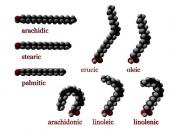Abstract: The purpose of this lab was to identify an unknown edible oil sample. Gas chromatographic analysis of the fatty acid methyl esters was conducted to find an unknown sample of oil. It was found that the unknown oil was olive oil. Saponification and methylation were methods that were used to prepare the sample for gas chromatography. Gas Chromatography of the olive oil showed peaks at palmitic, palmitoleic, stearic, linoleic, and alpha linolenic. The highest percentage from the chromatogram was oleic.
Introduction: Basic oils are essential for the human body. Oils are fatty acids that are utilized by the body for metabolic functioning. Fatty acids are a simple form of lipids. Lipids are chemical compounds that do not readily dissolve in water, but dissolve in organic solvents. Common lipids are Triglycerides and Phospholipids. Fatty acids consist of a carboxyl end at the alpha end and a methyl group at the omega end.
Fatty acids can be either saturated or unsaturated. Saturated fatty acids have a maximum amount of hydrogen atoms. They are solid at room temperature. Common saturated fatty acids are palmitic, stearic, and lauric. Unsaturated fatty acids do not contain a high amount of hydrogen atoms, but have a double bond. These fatty acids are liquids at room temperature. Common unsaturated fatty acids are linolenic and oleic acids. An example of this is shown in olive oil. Olive oil has a high percentage of oleic acid. It reduces LDL cholesterol. The accumulation of free radicals, as a result of oxidation in the body causes serious health problems. Vitamin-E and various phenols protect the body from these radicals. The consumption of Olive oil can prevent the invasion of free radicals and reduce the aging process. The human body cannot synthesize omega-3-fatty acids and Omega 6 fatty acids. The body...


